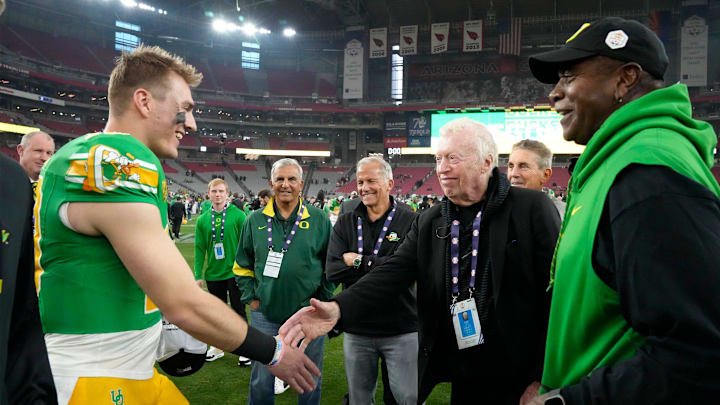Through the process of recruiting the class of 2026, Oregon has had five prospects de-commit, a circumstance which Duck fans are not used to. While my panic meter for this matter remains fairly low, it is still not up to the standard that Dan Lanning and his staff have set.
This trend is likely to turn around come June, as summer visits open up, and Dan Lanning does most of his work through the summer and into the fall, all the way up to signing day. Oregon is not "out" on many of the prospects on their radar.
In these de-commitments, there are any number of reasons that one could come up with, whether it is regionality, a faster path to playing time, or stronger NIL packages, they are all plausible.
Thanks to the good folks at 247 Sports Duck Territory, we may finally have a solid answer for at least some of the struggles we have seen, primarily in the high NIL earners such as QB Jared Curtis and OT Jackson Cantwell, who committed to Georgia and Miami respectively.
Life comes at fast https://t.co/uxwL4z7Q3S pic.twitter.com/fBvddVBtIU
— dawg4life (@bowdown79) May 29, 2025
Ignore the Washington fan and their poor grammar, and take a look at the content there.
Originally reported by 247Sports Duck Territory's Jared Skopil, Matt Prehm, they discussed how the NIL strategy from Oregon's donors, such as Division Street, have changed. This strategy is also being backed by Oregon athletic director Rob Mullens.

Reportedly, the focus has shifted from paying out much of their NIL to high school prospects, to using the money toward roster retention and transfer players.
This strategy certainly has its strengths. The previous two national champions, Michigan and Ohio State, have used that same formula in order to complete the ultimate goal. Retain your best players leaving their junior seasons, and plug holes with elite transfer players.
Imagine a world where Matayo Uiagalelei, Kenyon Sadiq, Poncho Laloulu, Dante Moore, Dillon Thieneman, Makhi Hughes, Justius Lowe, Teitum Tuioti and A'mauri Washington all remained Ducks for the 2026 season. Obviously having every single one of them return to Oregon is a bit of a reach, but even if a majority returned, it would be a great sign for the Ducks.

That is certainly its strength. While some of those are the elite transfers who align with the previously discussed strategy, a bulk are players acquired through the high school ranks. High school recruiting still reigns supreme, and is still the best way to build a great team.
Build through high school, plug holes with elite transfers, and retain your best players. That is the model for success, and all three aspects are of equal value. Solely relying on the portal can lead to very hit and miss results. Ask Mike Norvell or Deion Sanders about the negative side of it, and how it worked for them.

Overall, I do believe that this strategy will be a net positive for the Ducks, especially given Dan Lanning and his staff's ability to quickly develop and prepare transfer players, however, I do not want the attention to completely shift away from the high school ranks.
Either way, Dan Lanning himself, and the members of his staff are elite recruiters. Even with the NIL dominance of the high school ranks, relationships and recruiting still matter, and few are better at building those relationships than Lanning.
As Matt Prehm said in the article, "time will tell."
